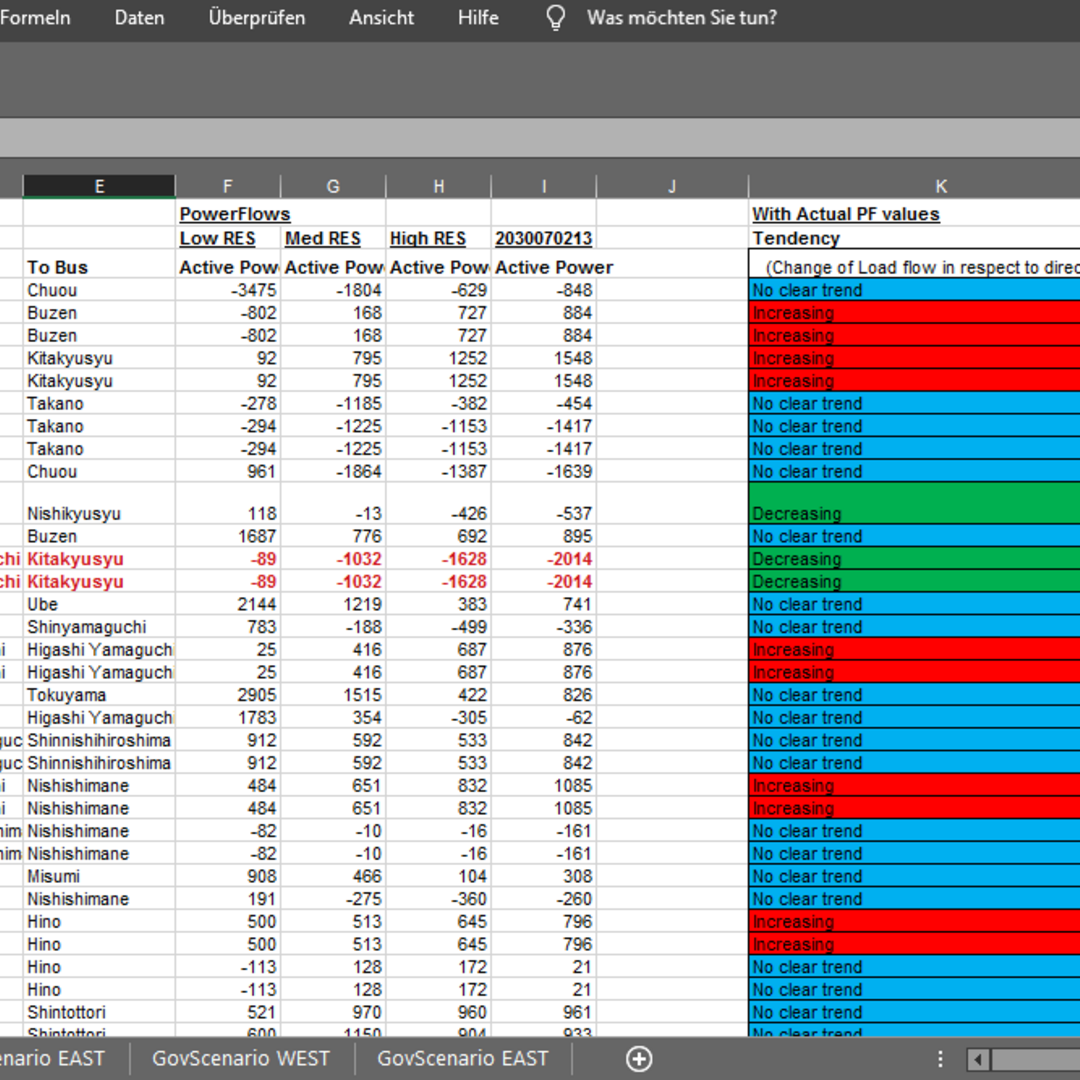-
The Japanese power system can accommodate a larger proportion of renewables (RES) than is currently provided for in the government’s 2030 targets, while still maintaining grid stability.
An annual share of at least 33% RES (22% variable renewables – VRES) can easily be integrated, while still maintaining grid stability within a tolerable range. A higher renewable share of 40% (30% VRES) could also be achieved with very low curtailment level.
-
There already exist a number of technical measures to improve grid stability in situations where a high proportion of variable renewables could place a strain on grid operations.
Indeed, VRES can contribute to maintaining grid stability by providing fast frequency response (FFR). On conservative assumptions, this study shows that such FFR services would enable the existing Japanese transmission grid to incorporate instantaneous VRES penetration levels of up to 60% in eastern Japan and around 70% in western Japan, while still maintaining frequency stability. These assessments confirm the trends observed in 2018 in regions such as Kyushu or Shikoku, where hourly VRES penetration satisfied more than 80% of demand (corresponding to more than 55% of all power generation). By 2030, these high regional infeed levels could become the norm for the Japanese system as a whole. Furthermore, implementing additional technical measures would allow even higher penetration levels to be reached.
-
Integrated grid and resource planning can help mitigate the impact of wind and solar PV
deployment on intraregional and interregional load flows.
Increasing the proportion of VRES in the mix is expected to reduce power line loading in some regions and increase it in other parts of the system. The impact of VRES distribution on the grid must therefore be systematically taken into account in future grid development plans, in order to avoid creating line-loading hotspots.
-
Non-discriminatory market regulations, enhanced transparency, and state-of-the-art operational and planning practices facilitate the integration of a higher proportion of variable renewables.
In particular, renewables should be incorporated into ancillary service provision, since they can contribute to frequency stability, balancing, and voltage control in tandem with other technologies (such as demand side response, conventional generation, and storage).
- Format
- Study
- Date
- 23 April 2019
Integrating renewables into the Japanese power grid by 2030
A frequency stability and load flow analysis of the Japanese system in response to high renewables penetration levels

Preface
As the cost of wind and solar power generation has drastically fallen, these technologies have come to make a major contribution to the decarbonisation of power systems. In Japan, solar photovoltaic uptake has risen rapidly over the last five years, making the country one of the most dynamic photovoltaic markets outside China. While the proportion of variable renewables in the Japanese system is increasing, however, it remains rather low, at around 7%.
Concerns over whether renewables can be efficiently integrated into Japan’s power grids without endangering grid stability have raised the spectre of a re newables slowdown in the country. International experience has shown, however, that a number of technical measures that are not yet widespread in Japan can be safely implemented to improve grid stability. Unfortunately, there are very few studies in the public domain on these aspects of Japan’s power system.
In this study, Japan’s Renewable Energy Institute (REI) and Agora Energiewende attempt to partially fill this lacuna. As well as providing new insights into grid stability in Japan, the study also promotes data transparency. We are firmly convinced that third party analysis on the basis of transparent data can contribute to a more robust discussion and ultimately raise societal awareness of the importance of the energy transition.
Key findings
Bibliographical data
- Authors
- Peter Merk, Elia Grid International; MSc. Rena Kuwahata, Elia Grid International; Dr. Steffen Rabe, GridLab; Assoc. prof. Tatsuya Wakeyama, Renewable Energy Institute; Shota Ichimura, Renewable Energy Institute; Dimitri Pescia, Agora Energiewende
- Publication number
- 148/1-S-2019/EN
- Version number
- 1.0
- Publication date
-
23 April 2019
- Pages
- 108
- Suggested Citation
- Renewable Energy Institute, Agora Energiewende (2018): Integrating renewables into the Japanese power grid by 2030. Study on behalf of Renewable Energy Institute and Agora Energiewende
- Project
- This publication was produced within the framework of the project Integrating renewables into the Japanese power grid.
Downloads
-
Main Report
pdf 4 MB
Integrating renewables into the Japanese power grid by 2030
A frequency stability and load flow analysis of the Japanese system in response to high renewables penetration levels
-
Translation
pdf 5 MB
2030 年日本における変動型 自然エネルギーの大量導入と 電力システムの安定性分析
Japanese translation
-
Slide Deck
pdf 6 MB
Integrating renewables into the Japanese power grid by 2030
Presentation of the Japan grid study, April 2019
All figures in this publication
Steady state transition
Figure 1 from Integrating renewables into the Japanese power grid by 2030 on page 19
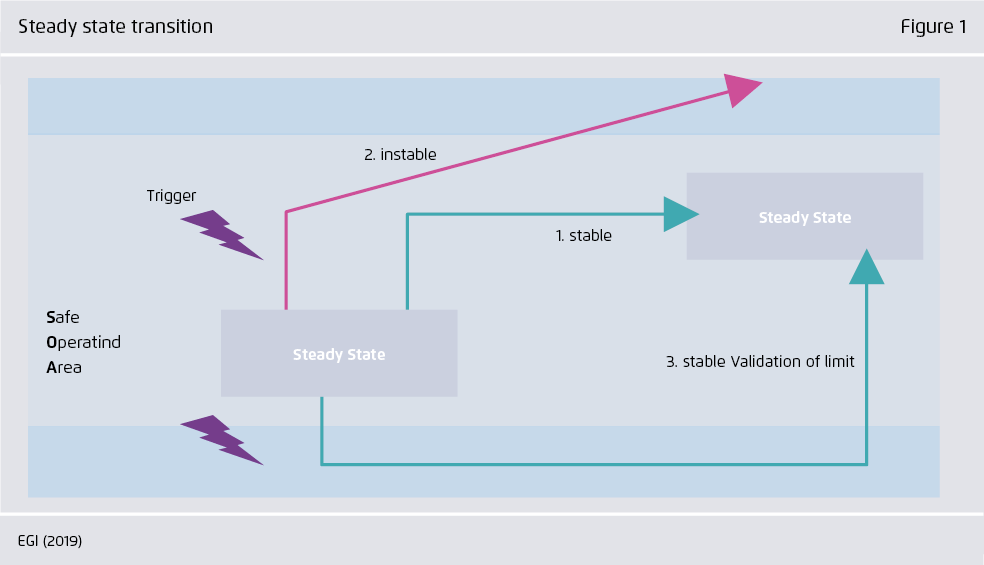
Under consideration of the Creative Commons license CC BY (attribution) the image may be further processed in any format or medium (also commercially, also in modified form), as long as the author is mentioned and a link to the license is given.
Power system stability overview
Figure 2 from Integrating renewables into the Japanese power grid by 2030 on page 20
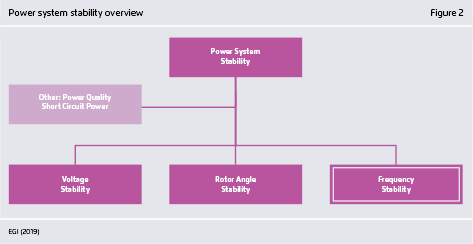
Under consideration of the Creative Commons license CC BY (attribution) the image may be further processed in any format or medium (also commercially, also in modified form), as long as the author is mentioned and a link to the license is given.
Typical frequency response behaviour in the event of a loss of generation
Figure 3 from Integrating renewables into the Japanese power grid by 2030 on page 22
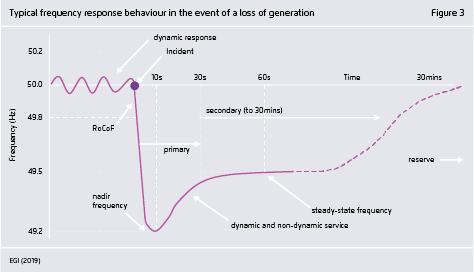
Under consideration of the Creative Commons license CC BY (attribution) the image may be further processed in any format or medium (also commercially, also in modified form), as long as the author is mentioned and a link to the license is given.
Overall modelling and simulation procedure
Figure 4 from Integrating renewables into the Japanese power grid by 2030 on page 25
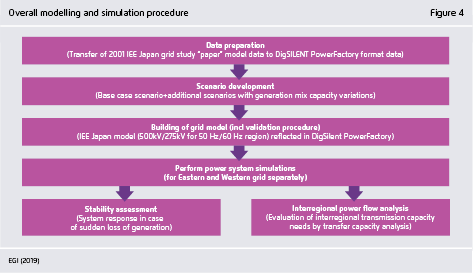
Under consideration of the Creative Commons license CC BY (attribution) the image may be further processed in any format or medium (also commercially, also in modified form), as long as the author is mentioned and a link to the license is given.
Grid model for the Eastern Synchronous Area
Figure 5 from Integrating renewables into the Japanese power grid by 2030 on page 26
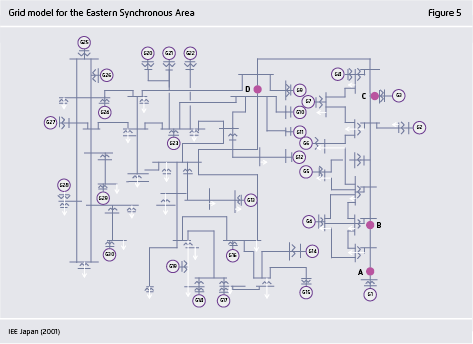
Under consideration of the Creative Commons license CC BY (attribution) the image may be further processed in any format or medium (also commercially, also in modified form), as long as the author is mentioned and a link to the license is given.
Installed capacities per region in the GovS and +RES
Figure 6 from Integrating renewables into the Japanese power grid by 2030 on page 28
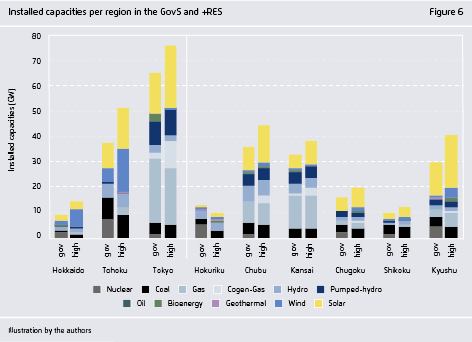
Under consideration of the Creative Commons license CC BY (attribution) the image may be further processed in any format or medium (also commercially, also in modified form), as long as the author is mentioned and a link to the license is given.
VRES levels during peak hours (1pm) in the +RES scenario
Figure 7 from Integrating renewables into the Japanese power grid by 2030 on page 28
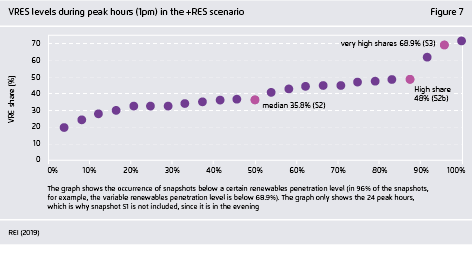
Under consideration of the Creative Commons license CC BY (attribution) the image may be further processed in any format or medium (also commercially, also in modified form), as long as the author is mentioned and a link to the license is given.
Frequency response after a 1,500 MW generation loss in eastern Japan in the government scenario
Figure 8 from Integrating renewables into the Japanese power grid by 2030 on page 34
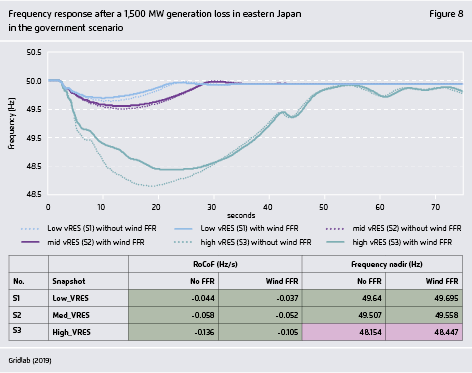
Under consideration of the Creative Commons license CC BY (attribution) the image may be further processed in any format or medium (also commercially, also in modified form), as long as the author is mentioned and a link to the license is given.
Frequency response after a 1,500 MW generation loss in western Japan in the government scenario
Figure 9 from Integrating renewables into the Japanese power grid by 2030 on page 35
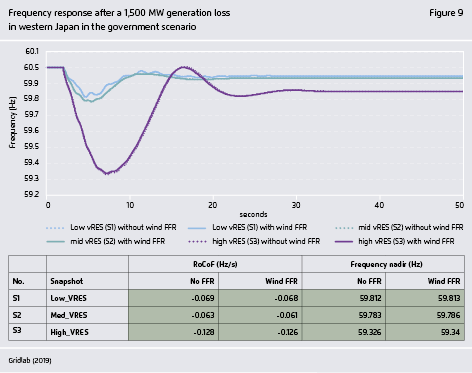
Under consideration of the Creative Commons license CC BY (attribution) the image may be further processed in any format or medium (also commercially, also in modified form), as long as the author is mentioned and a link to the license is given.
Frequency response after a 1,500 MW generation loss in eastern Japan in the higher RE scenario, with and without wind FFR
Figure 10 from Integrating renewables into the Japanese power grid by 2030 on page 37
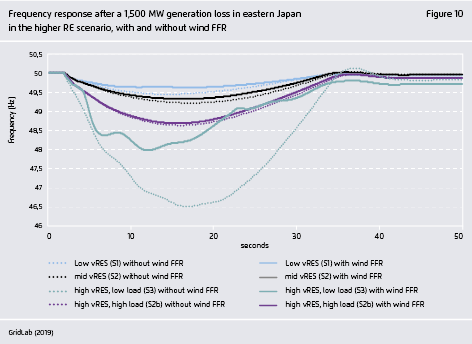
Under consideration of the Creative Commons license CC BY (attribution) the image may be further processed in any format or medium (also commercially, also in modified form), as long as the author is mentioned and a link to the license is given.
Frequency response by FFR technology after a 1,500 MW generation loss in eastern Japan in the higher RE scenario
Figure 11 from Integrating renewables into the Japanese power grid by 2030 on page 38
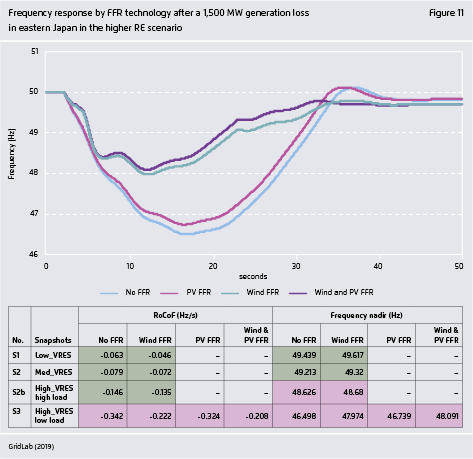
Under consideration of the Creative Commons license CC BY (attribution) the image may be further processed in any format or medium (also commercially, also in modified form), as long as the author is mentioned and a link to the license is given.
Frequency response after loss of 1,500 MW for western Japan +RES scenario; with and without wind and solar FFR
Figure 12 from Integrating renewables into the Japanese power grid by 2030 on page 39

Under consideration of the Creative Commons license CC BY (attribution) the image may be further processed in any format or medium (also commercially, also in modified form), as long as the author is mentioned and a link to the license is given.
Frequency response by FFR technology after a 1,500 MW generation loss in western Japan in the higher RE scenario
Figure 13 from Integrating renewables into the Japanese power grid by 2030 on page 40
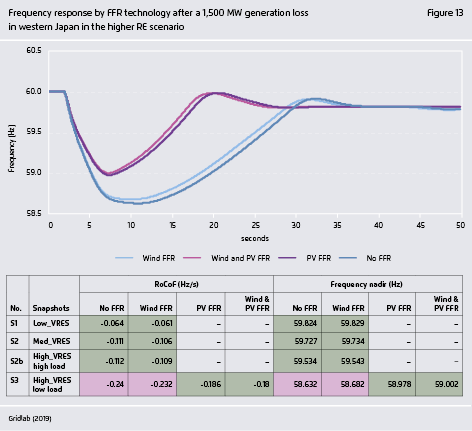
Under consideration of the Creative Commons license CC BY (attribution) the image may be further processed in any format or medium (also commercially, also in modified form), as long as the author is mentioned and a link to the license is given.
System inertia and VRES penetration in the GovS and +RES snapshots
Figure 14 from Integrating renewables into the Japanese power grid by 2030 on page 41
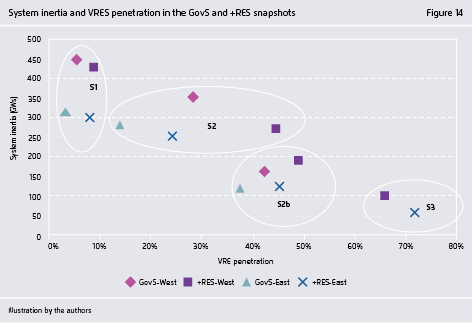
Under consideration of the Creative Commons license CC BY (attribution) the image may be further processed in any format or medium (also commercially, also in modified form), as long as the author is mentioned and a link to the license is given.
System inertia by region in different snapshots
Figure 15 from Integrating renewables into the Japanese power grid by 2030 on page 42
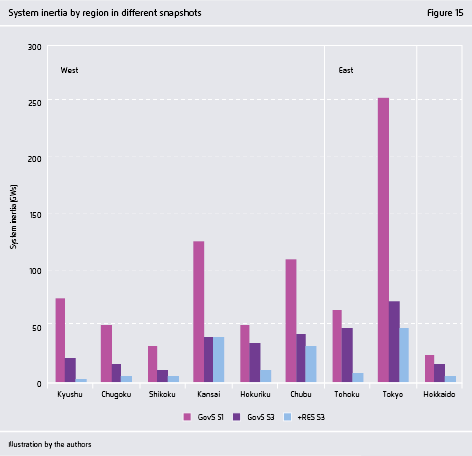
Under consideration of the Creative Commons license CC BY (attribution) the image may be further processed in any format or medium (also commercially, also in modified form), as long as the author is mentioned and a link to the license is given.
RoCoF and system inertia in the GovS and +RES snapshots
Figure 16 from Integrating renewables into the Japanese power grid by 2030 on page 44
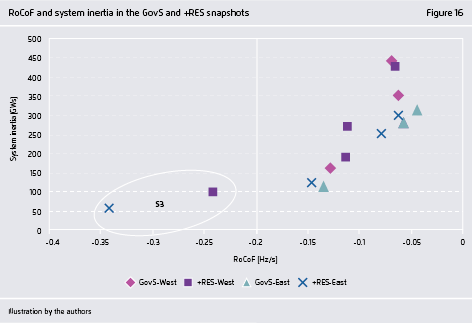
Under consideration of the Creative Commons license CC BY (attribution) the image may be further processed in any format or medium (also commercially, also in modified form), as long as the author is mentioned and a link to the license is given.
Frequency nadir: System inertia characteristics in the higher RE scenario
Figure 17 from Integrating renewables into the Japanese power grid by 2030 on page 45
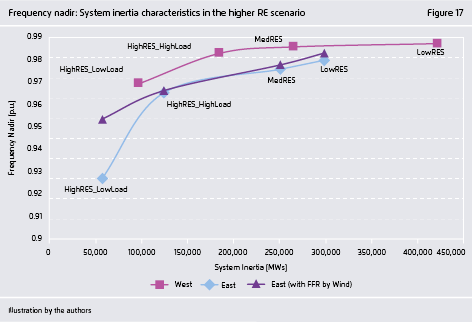
Under consideration of the Creative Commons license CC BY (attribution) the image may be further processed in any format or medium (also commercially, also in modified form), as long as the author is mentioned and a link to the license is given.
Frequency nadir as a function of variable RES shares in the higher RES scenario
Figure 18 from Integrating renewables into the Japanese power grid by 2030 on page 46
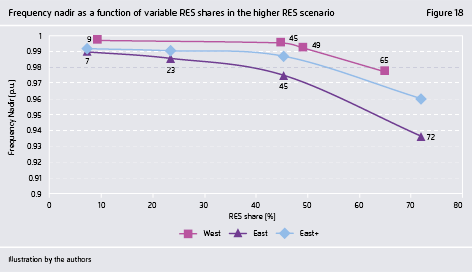
Under consideration of the Creative Commons license CC BY (attribution) the image may be further processed in any format or medium (also commercially, also in modified form), as long as the author is mentioned and a link to the license is given.
Frequency nadir as a function of variable RES shares in the higher RES scenario (with wind FFR)
Figure 19 from Integrating renewables into the Japanese power grid by 2030 on page 47
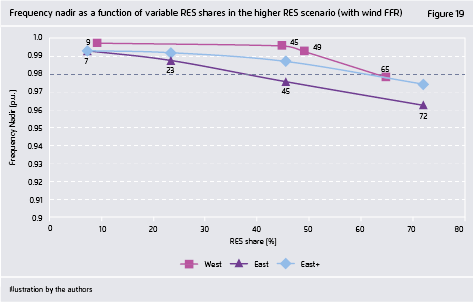
Under consideration of the Creative Commons license CC BY (attribution) the image may be further processed in any format or medium (also commercially, also in modified form), as long as the author is mentioned and a link to the license is given.
Nadir frequency and VRES penetration in eastern Japan with and without the 600MW ancillary service
Figure 20 from Integrating renewables into the Japanese power grid by 2030 on page 47
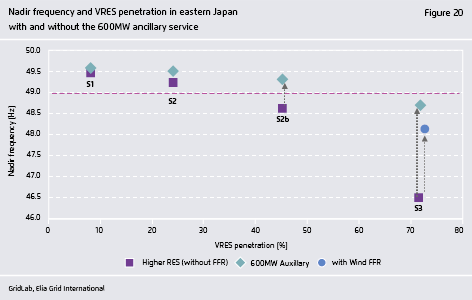
Under consideration of the Creative Commons license CC BY (attribution) the image may be further processed in any format or medium (also commercially, also in modified form), as long as the author is mentioned and a link to the license is given.
Nadir frequency and VRES penetration in western Japan by snapshot
Figure 21 from Integrating renewables into the Japanese power grid by 2030 on page 49
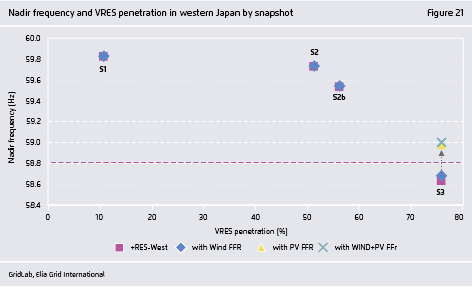
Under consideration of the Creative Commons license CC BY (attribution) the image may be further processed in any format or medium (also commercially, also in modified form), as long as the author is mentioned and a link to the license is given.
Excerpt from Danish regulations for wind farms connected at a voltage level above 100kV
Figure 22 from Integrating renewables into the Japanese power grid by 2030 on page 22
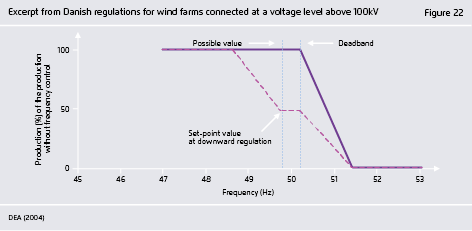
Under consideration of the Creative Commons license CC BY (attribution) the image may be further processed in any format or medium (also commercially, also in modified form), as long as the author is mentioned and a link to the license is given.
Grid following mode configuration from the Irish frequency response tests
Figure 23 from Integrating renewables into the Japanese power grid by 2030 on page 59
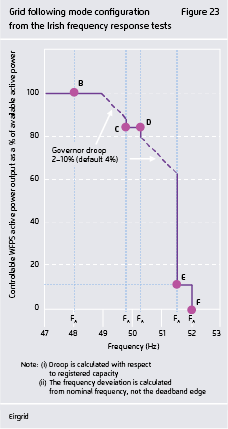
Under consideration of the Creative Commons license CC BY (attribution) the image may be further processed in any format or medium (also commercially, also in modified form), as long as the author is mentioned and a link to the license is given.
Representation of the simulation toolchain
Figure 24 from Integrating renewables into the Japanese power grid by 2030 on page 65
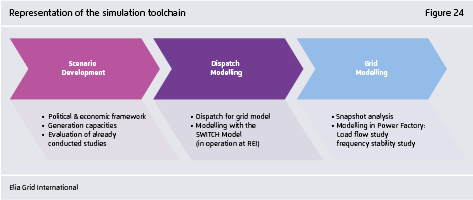
Under consideration of the Creative Commons license CC BY (attribution) the image may be further processed in any format or medium (also commercially, also in modified form), as long as the author is mentioned and a link to the license is given.
NTC Values assumed in the SWITCH simulation
Figure 25 from Integrating renewables into the Japanese power grid by 2030 on page 25
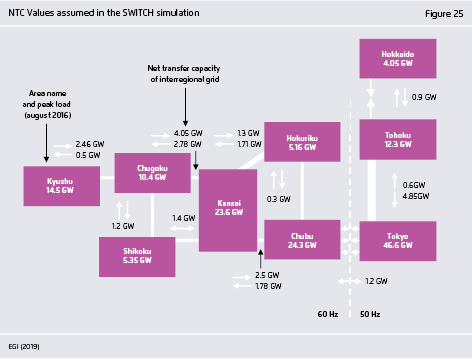
Under consideration of the Creative Commons license CC BY (attribution) the image may be further processed in any format or medium (also commercially, also in modified form), as long as the author is mentioned and a link to the license is given.
Demand curve used in the SWITCH model
Figure 26 from Integrating renewables into the Japanese power grid by 2030 on page 72
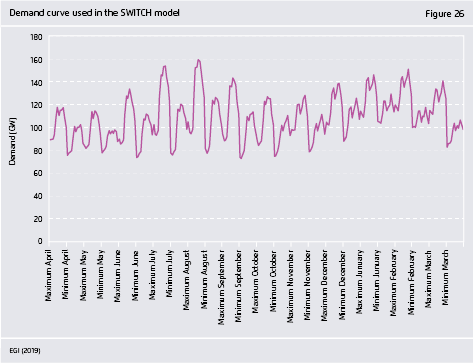
Under consideration of the Creative Commons license CC BY (attribution) the image may be further processed in any format or medium (also commercially, also in modified form), as long as the author is mentioned and a link to the license is given.
Overview of generation output in the Government scenario
Figure 27 from Integrating renewables into the Japanese power grid by 2030 on page 75
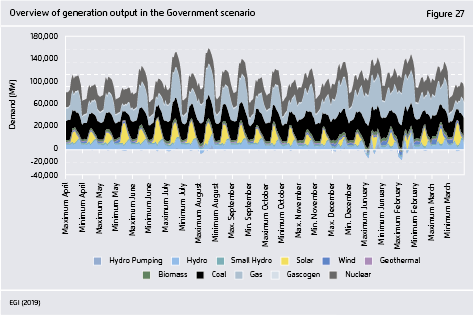
Under consideration of the Creative Commons license CC BY (attribution) the image may be further processed in any format or medium (also commercially, also in modified form), as long as the author is mentioned and a link to the license is given.
Overview of generation output in the +RES scenario
Figure 28 from Integrating renewables into the Japanese power grid by 2030 on page 76
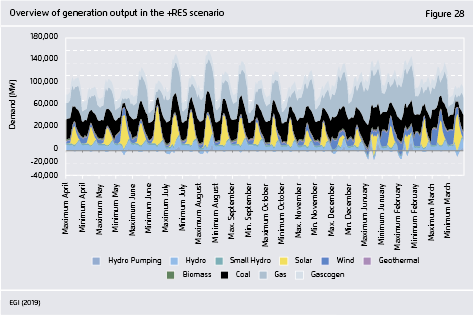
Under consideration of the Creative Commons license CC BY (attribution) the image may be further processed in any format or medium (also commercially, also in modified form), as long as the author is mentioned and a link to the license is given.
Infeed snapshot 1
Figure 29 from Integrating renewables into the Japanese power grid by 2030 on page 77
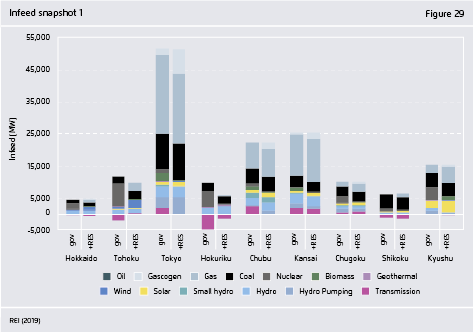
Under consideration of the Creative Commons license CC BY (attribution) the image may be further processed in any format or medium (also commercially, also in modified form), as long as the author is mentioned and a link to the license is given.
Infeed snapshot 2
Figure 30 from Integrating renewables into the Japanese power grid by 2030 on page 78
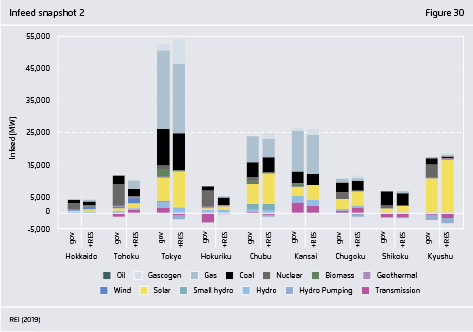
Under consideration of the Creative Commons license CC BY (attribution) the image may be further processed in any format or medium (also commercially, also in modified form), as long as the author is mentioned and a link to the license is given.
Infeed snapshot 3
Figure 31 from Integrating renewables into the Japanese power grid by 2030 on page 79
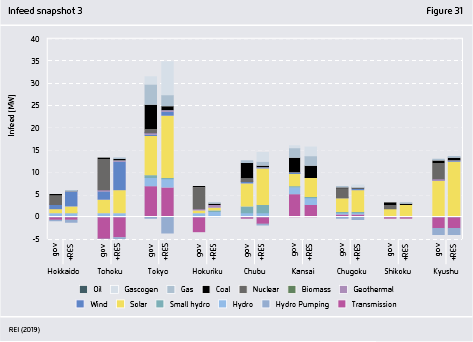
Under consideration of the Creative Commons license CC BY (attribution) the image may be further processed in any format or medium (also commercially, also in modified form), as long as the author is mentioned and a link to the license is given.
Overall modelling and simulation procedure
Figure 32 from Integrating renewables into the Japanese power grid by 2030 on page 81
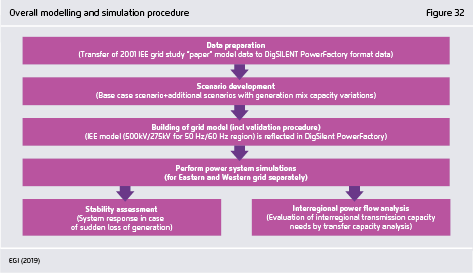
Under consideration of the Creative Commons license CC BY (attribution) the image may be further processed in any format or medium (also commercially, also in modified form), as long as the author is mentioned and a link to the license is given.
Outline of the IEE EAST 30-machine system model (IEE Japan)
Figure 33 from Integrating renewables into the Japanese power grid by 2030 on page 82
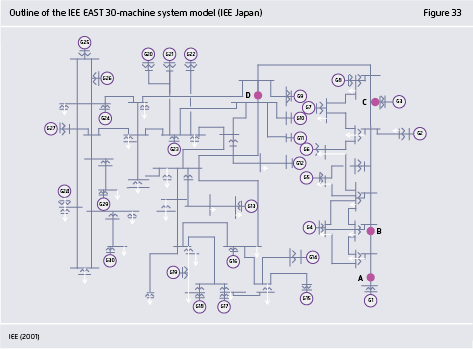
Under consideration of the Creative Commons license CC BY (attribution) the image may be further processed in any format or medium (also commercially, also in modified form), as long as the author is mentioned and a link to the license is given.
Import procedure for steady state Y-method data into PowerFactory
Figure 34 from Integrating renewables into the Japanese power grid by 2030 on page 83
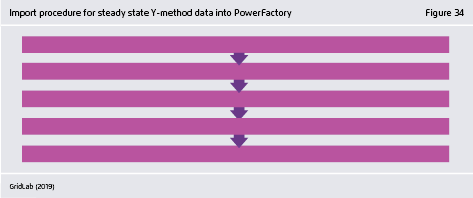
Under consideration of the Creative Commons license CC BY (attribution) the image may be further processed in any format or medium (also commercially, also in modified form), as long as the author is mentioned and a link to the license is given.
Final PowerFactory network graphic for the eastern Japan grid (50 Hz area)
Figure 35 from Integrating renewables into the Japanese power grid by 2030 on page 84
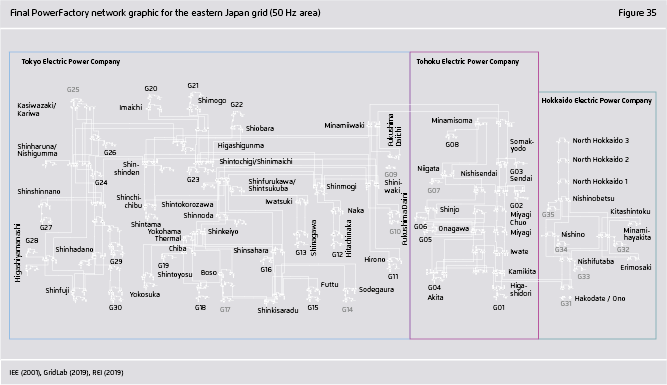
Under consideration of the Creative Commons license CC BY (attribution) the image may be further processed in any format or medium (also commercially, also in modified form), as long as the author is mentioned and a link to the license is given.
Final PowerFactory network graphic for the western Japan grid (60 Hz area)
Figure 36 from Integrating renewables into the Japanese power grid by 2030 on page 85
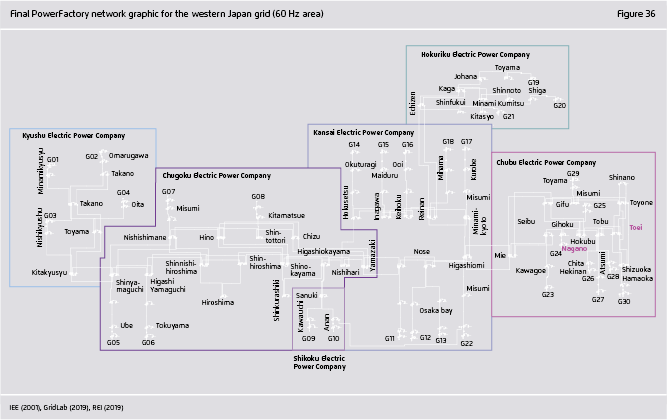
Under consideration of the Creative Commons license CC BY (attribution) the image may be further processed in any format or medium (also commercially, also in modified form), as long as the author is mentioned and a link to the license is given.
AVR model according to the IEE documentation
Figure 37 from Integrating renewables into the Japanese power grid by 2030 on page 86
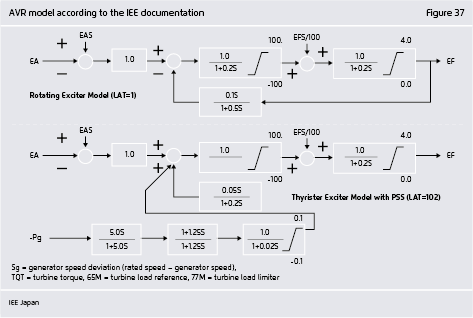
Under consideration of the Creative Commons license CC BY (attribution) the image may be further processed in any format or medium (also commercially, also in modified form), as long as the author is mentioned and a link to the license is given.
Governor models according to the IEE documentation (IEE Japan, 2018)
Figure 38 from Integrating renewables into the Japanese power grid by 2030 on page 87
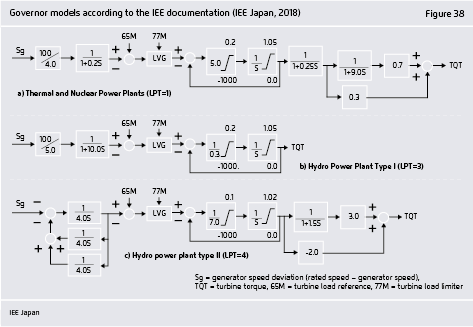
Under consideration of the Creative Commons license CC BY (attribution) the image may be further processed in any format or medium (also commercially, also in modified form), as long as the author is mentioned and a link to the license is given.
Results for a 1-circuit fault in the western grid at a specified disturbance point, with the fault clearing after 0.07 s
Figure 39 from Integrating renewables into the Japanese power grid by 2030 on page 91
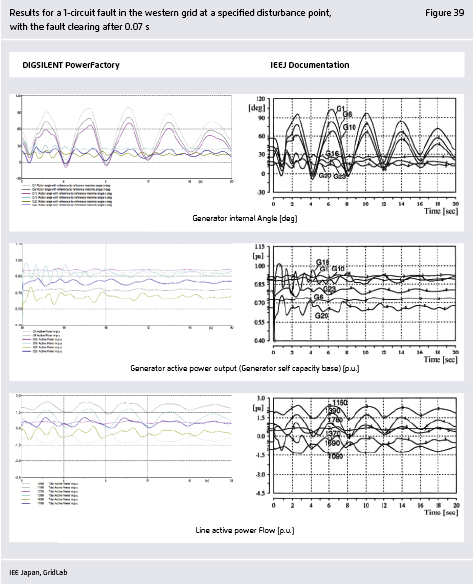
Under consideration of the Creative Commons license CC BY (attribution) the image may be further processed in any format or medium (also commercially, also in modified form), as long as the author is mentioned and a link to the license is given.
Results for a 1-circuit fault in the eastern grid at a specified disturbance point, with the fault clearing after 0.07 s
Figure 40 from Integrating renewables into the Japanese power grid by 2030 on page 92
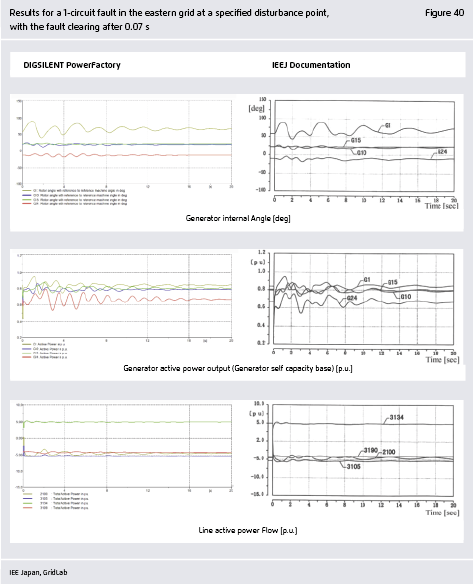
Under consideration of the Creative Commons license CC BY (attribution) the image may be further processed in any format or medium (also commercially, also in modified form), as long as the author is mentioned and a link to the license is given.
Frequency drop from nominal and RoCoF when load shedding starts for selected regions
Figure 41 from Integrating renewables into the Japanese power grid by 2030 on page 94
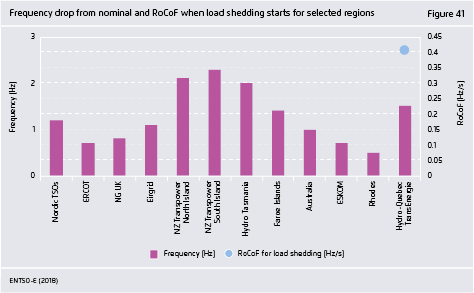
Under consideration of the Creative Commons license CC BY (attribution) the image may be further processed in any format or medium (also commercially, also in modified form), as long as the author is mentioned and a link to the license is given.
Eastern Japan network model representation in PowerFactory with the fault location highlighted
Figure 42 from Integrating renewables into the Japanese power grid by 2030 on page 95
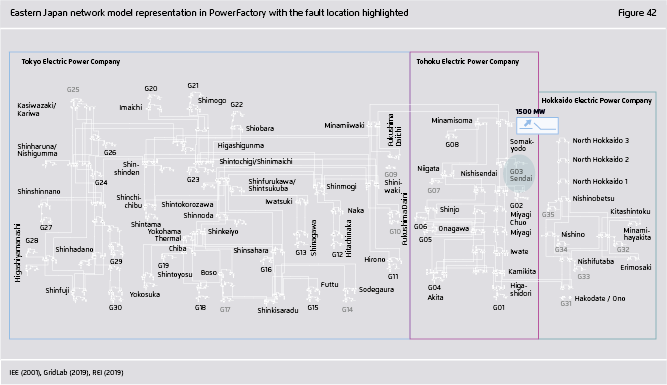
Under consideration of the Creative Commons license CC BY (attribution) the image may be further processed in any format or medium (also commercially, also in modified form), as long as the author is mentioned and a link to the license is given.
Frequency response for the base case scenario (2001 situation)
Figure 43 from Integrating renewables into the Japanese power grid by 2030 on page 96
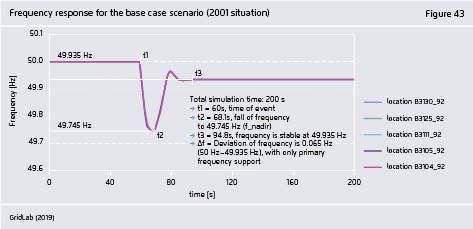
Under consideration of the Creative Commons license CC BY (attribution) the image may be further processed in any format or medium (also commercially, also in modified form), as long as the author is mentioned and a link to the license is given.
Related RoCoF characteristics for different locations in the eastern Japan network
Figure 44 from Integrating renewables into the Japanese power grid by 2030 on page 96
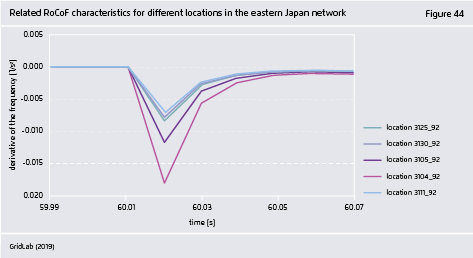
Under consideration of the Creative Commons license CC BY (attribution) the image may be further processed in any format or medium (also commercially, also in modified form), as long as the author is mentioned and a link to the license is given.
Zoomed view of frequency response for the graphical RoCoF calculation
Figure 45 from Integrating renewables into the Japanese power grid by 2030 on page 97
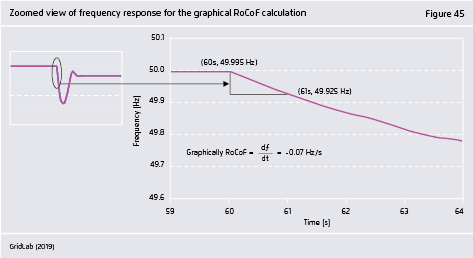
Under consideration of the Creative Commons license CC BY (attribution) the image may be further processed in any format or medium (also commercially, also in modified form), as long as the author is mentioned and a link to the license is given.
Virtual inertia response time frame
Figure 46 from Integrating renewables into the Japanese power grid by 2030 on page 99
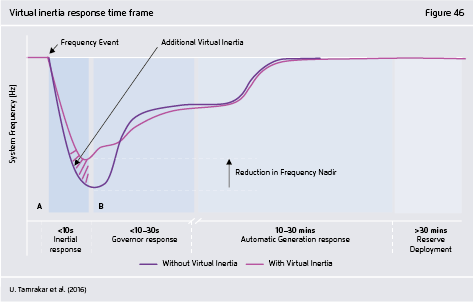
Under consideration of the Creative Commons license CC BY (attribution) the image may be further processed in any format or medium (also commercially, also in modified form), as long as the author is mentioned and a link to the license is given.
Inertia coupling
Figure 47 from Integrating renewables into the Japanese power grid by 2030 on page 100
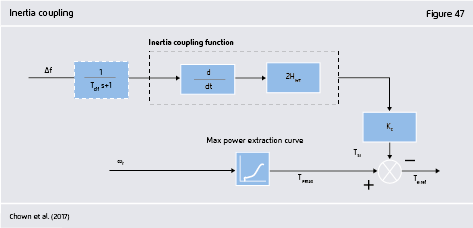
Under consideration of the Creative Commons license CC BY (attribution) the image may be further processed in any format or medium (also commercially, also in modified form), as long as the author is mentioned and a link to the license is given.
Wind turbine virtual inertia response model
Figure 48 from Integrating renewables into the Japanese power grid by 2030 on page 100
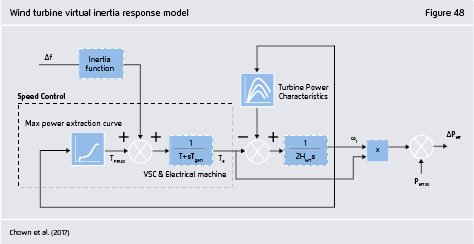
Under consideration of the Creative Commons license CC BY (attribution) the image may be further processed in any format or medium (also commercially, also in modified form), as long as the author is mentioned and a link to the license is given.
FFR characteristics of wind energy turbines
Figure 49 from Integrating renewables into the Japanese power grid by 2030 on page 101
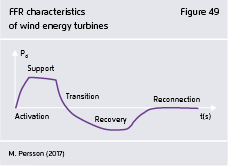
Under consideration of the Creative Commons license CC BY (attribution) the image may be further processed in any format or medium (also commercially, also in modified form), as long as the author is mentioned and a link to the license is given.
FFR modelling in DIgSILENT PowerFactory
Figure 50 from Integrating renewables into the Japanese power grid by 2030 on page 101
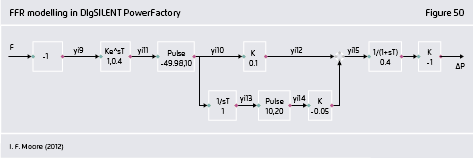
Under consideration of the Creative Commons license CC BY (attribution) the image may be further processed in any format or medium (also commercially, also in modified form), as long as the author is mentioned and a link to the license is given.
FFR controller response of a wind turbine
Figure 51 from Integrating renewables into the Japanese power grid by 2030 on page 102
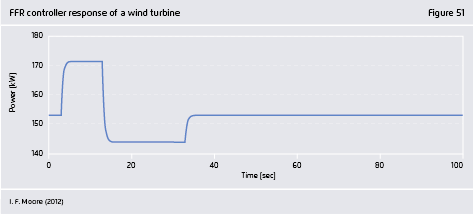
Under consideration of the Creative Commons license CC BY (attribution) the image may be further processed in any format or medium (also commercially, also in modified form), as long as the author is mentioned and a link to the license is given.
Deloaded operation of PV systems
Figure 52 from Integrating renewables into the Japanese power grid by 2030 on page 102
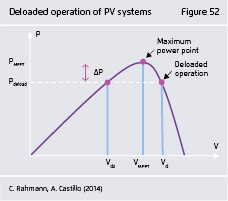
Under consideration of the Creative Commons license CC BY (attribution) the image may be further processed in any format or medium (also commercially, also in modified form), as long as the author is mentioned and a link to the license is given.
Frequency controller in WECC model
Figure 53 from Integrating renewables into the Japanese power grid by 2030 on page 103
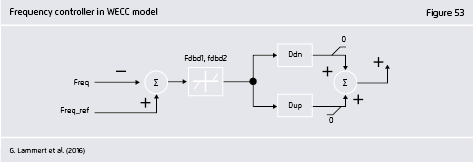
Under consideration of the Creative Commons license CC BY (attribution) the image may be further processed in any format or medium (also commercially, also in modified form), as long as the author is mentioned and a link to the license is given.



